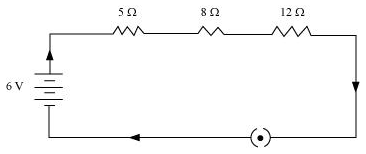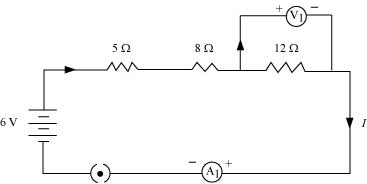NCERT Solution: Electricity
The energy given to each coulomb of charge is equal to the amount of work which is done in moving it.
Now we know that,
Potential difference = Work Done/Charge
∴ Work done = Potential difference × charge
Where, Charge = 1 C and Potential difference = 6 V
∴ Work done = 6 × 1
= 6 Joule.
The resistance of a conductor depends upon the following factors:
→ Length of the conductor
→ Cross-sectional area of the conductor
→ Material of the conductor
→ Temperature of the conductor
The current will flow more easily through thick wire. It is because the resistance of a conductor is inversely proportional to its area of cross – section. If thicker the wire, less is resistance and hence more easily the current flows.
According to Ohm’s law
V = IR
⇒ I=V/R … (1)
Now Potential difference is decreased to half
∴ New potential difference Vʹ=V/2
Resistance remains constant
So the new current Iʹ = Vʹ/R
= (V/2)/R
= (1/2) (V/R)
= (1/2) I = I/2
Therefore, the amount of current flowing through the electrical component is reduced by half.
The resistivity of an alloy is higher than the pure metal. Moreover, at high temperatures, the alloys do not melt readily. Hence, the coils of heating appliances such as electric toasters and electric irons are made of an alloy rather than a pure metal.
Table 12.2 Electrical resistivity of some substances at 20�C
| Material | Resistivity (Ω m) | |
| Conductors | Silver | 1.60 � 10−8 |
| Copper | 1.62 � 10−8 | |
| Aluminium | 2.63 � 10−8 | |
| Tungsten | 5.20 � 10−8 | |
| Nickel | 6.84 � 10−8 | |
| Iron | 10.0 � 10−8 | |
| Chromium | 12.9 � 10−8 | |
| Mercury | 94.0 � 10−8 | |
| Manganese | 1.84 � 10−6 | |
|
Constantan (alloy of Cu and Ni) |
49 � 10−6 | |
| Alloys |
Manganin (alloy of Cu, Mn and Ni) |
44 � 10−6 |
|
Nichrome (alloy of Ni, Cr, Mn and Fe) |
100 � 10−6 | |
| Glass | 1010 − 1014 | |
| Insulators | Hard rubber | 1013 − 1016 |
| Ebonite | 1015 − 1017 | |
| Diamond | 1012 − 1013 | |
| Paper (dry) | 1012 |
(a) Resistivity of iron = 10.0 x 10-8 Ω
Resistivity of mercury = 94.0 x 10-8 Ω
Resistivity of mercury is more than that of iron. This implies that iron is a
better conductor than mercury.
(b) It can be observed from Table 12.2 that the resistivity of silver is the
lowest among the listed materials. Hence, it is the best conductor.


The resistances are connected in series.
Ohm’s law can be used to obtain the readings of ammeter and voltmeter. According
to Ohm’s law,
V = IR,
Where,
Potential difference, V = 6 V
Current flowing through the circuit/resistors = I
Resistance of the circuit, R = 5 + 8 + 12 = 25Ω
I = V/R = 6/25 = 0.24 A
Potential difference across 12 Ω resistor = V1
Current flowing through the 12 Ω resistor, I = 0.24 A
Therefore, using Ohm’s law, we obtain
V1 = IR = 0.24 x 12 = 2.88 V
Therefore, the reading of the ammeter will be 0.24 A.
The reading of the voltmeter will be 2.88 V.